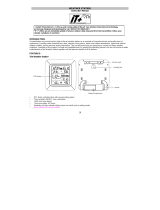
45
Note :
After setting up, readings for weather forecasts should be disregarded for the next 12-24 hours. This will
allow sufficient time for the Weather Station to collect air pressure data at a constant altitude and therefore
result in a more accurate forecast.
Common to weather forecasting, absolute accuracy cannot be guaranteed. The weather forecasting
feature is estimated to have an accuracy level of about 75% due to the varying areas the Weather Station
has been designed for use in. In areas that experience sudden changes in weather (for example from
sunny to rain), the Weather Station will be more accurate compared to use in areas where the weather is
stagnant most of the time (for example mostly sunny).
If the Weather Station is moved to another location significantly higher or lower than its initial standing
point (for example from the ground floor to the upper floors of a house), remove the batteries and re-insert
them after about 30 seconds. By doing this, the Weather Station will not mistake the new location as being
a possible change in air-pressure when really it is due to the slight change of altitude. Again, disregard
weather forecasts for the next 12 to 24 hours as this will allow time for operation at a constant altitude.
THE WEATHER TENDENCY INDICATOR:
Working together with the weather icons are the weather tendency indicators (located on the left and right
hand side of the weather icons). When the indicator points upwards, it means that the air-pressure is





















